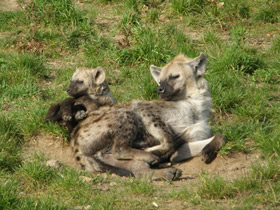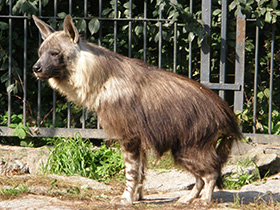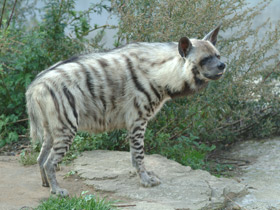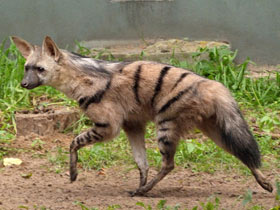Hyenas or hyaenas (Hyaenidae)
Hyenas or hyaenas (/haɪˈjiːnə/ HI-yee-nə; from Ancient Greek ὕαινα, hýaina), are feliform carnivoran mammals belonging to the family Hyaenidae /haɪˈɛnɪdiː/. With just four extant species (each in its own genus), it is the fifth-smallest family in the Carnivora and one of the smallest in the class Mammalia. Despite their low diversity, hyenas are unique and vital components of most African ecosystems.
Although phylogenetically closer to felines and viverrids, hyenas are behaviourally and morphologically similar to canids in several elements due to convergent evolution: both hyenas and canines are non-arboreal, cursorial hunters that catch prey with their teeth rather than claws. Both eat food quickly and may store it, and their calloused feet with large, blunt, nonretractable claws are adapted for running and making sharp turns. However, hyenas' grooming, scent marking, defecation habits, mating and parental behavior are consistent with the behavior of other feliforms.
Hyenas feature prominently in the folklore and mythology of human cultures that live alongside them. Hyenas are commonly viewed as frightening and worthy of contempt. In some cultures, hyenas are thought to influence people's spirits, rob graves, and steal livestock and children. Other cultures associate them with witchcraft, using their body parts in traditional medicine.
The hyenas (Hyaenidae), commonly known as hyenas, are a family of carnivorous mammals belonging to the suborder Feliformia. It is the least numerous family in its order (consisting of four species), and one of the smallest of the mammalian families.
Hyenas have a very characteristic appearance: they have a short head with a broad, powerful muzzle, large, rounded ears, short hind legs, a sloping back, sparse hair, a shaggy tail and a mane on the neck and along the back. Hyenas have the strongest jaws of all mammals, producing a bite pressure of about 70 kg/cm2. The limbs of hyenas are four-toed, with uninvolved claws; while running and walking, it treads with its toes and, although not very graceful, can reach speeds of up to 65 km/h.
Genera of the Hyaenidae (extinct and recent)
The list follows McKenna and Bell's Classification of Mammals for prehistoric genera (1997) and Wozencraft (2005) in Wilson and Reeders Mammal Species of the World for extant genera. The percrocutids are, in contrast to McKenna and Bell's classification, not included as a subfamily into the Hyaenidae, but as the separate family Percrocutidae (though they are generally grouped as sister-taxa to hyenas). Furthermore, the living brown hyena and its closest extinct relatives are not included in the genus Pachycrocuta, but in the genus Parahyaena.
Family Hyaenidae:
- Subfamily Incertae sedis:
- †Tongxinictis (Middle Miocene of Asia);
- †Subfamily Ictitheriinae:
- †Herpestides (Early Miocene of Africa and Eurasia);
- †Plioviverrops (including Jordanictis, Protoviverrops, Mesoviverrops; Early Miocene to Early Pliocene of Europe, Late Miocene of Asia);
- †Ictitherium (=Galeotherium; including Lepthyaena, Sinictitherium, Paraictitherium; Middle Miocene of Africa, Late Miocene to Early Pliocene of Eurasia);
- †Thalassictis (including Palhyaena, Miohyaena, Hyaenictitherium, Hyaenalopex; Middle to Late Miocene of Asia, Late Miocene of Africa and Europe);
- †Hyaenotherium (Late Miocene to Early Pliocene of Eurasia);
- †Miohyaenotherium (Late Miocene of Europe);
- †Lycyaena (Late Miocene of Eurasia);
- †Tungurictis (Middle Miocene of Africa and Eurasia);
- †Protictitherium (Middle Miocene of Africa and Asia, Middle to Late Miocene of Europe);
- Subfamily Hyaeninae:
- †Palinhyaena (Late Miocene of Asia);
- †Ikelohyaena (Early Pliocene of Africa);
- Hyaena (=Euhyaena,=Parahyaena; including striped hyena, Pliohyaena, Pliocrocuta, Anomalopithecus) Early Pliocene (?Middle Miocene) to Recent of Africa, Late Pliocene (?Late Miocene) to Late Pleistocene of Europe, Late Pliocene to recent in Asia;
- Parahyaena (=Hyaena; brown hyena Pliocene to recent of Africa);
- †Hyaenictis (Late Miocene of Asia?, Late Miocene of Europe, Early Pliocene (?Early Pleistocene) of Africa);
- †Leecyaena (Late Miocene and/or Early Pliocene of Asia);
- †Chasmaporthetes (=Ailuriaena; including Lycaenops, Euryboas; Late Miocene to Early Pleistocene of Eurasia, Early Pliocene to Late Pliocene or Early Pleistocene of Africa, Late Pliocene to Early Pleistocene of North America);
- †Pachycrocuta (Pliocene and Pleistocene of Eurasia and Africa);
- †Adcrocuta (Late Miocene of Eurasia);
- Crocuta (=Crocotta; including Eucrocuta; spotted hyena and cave hyena. Late Pliocene to recent of Africa, Late Pliocene to Late Pleistocene of Eurasia);
- Subfamily Protelinae;
- †Gansuyaena;
- Proteles (=Geocyon; aardwolf. Pleistocene to Recent of Africa).



















































